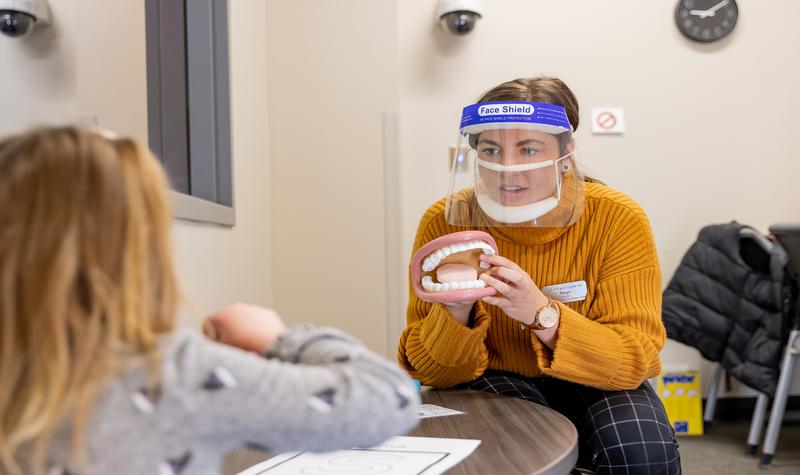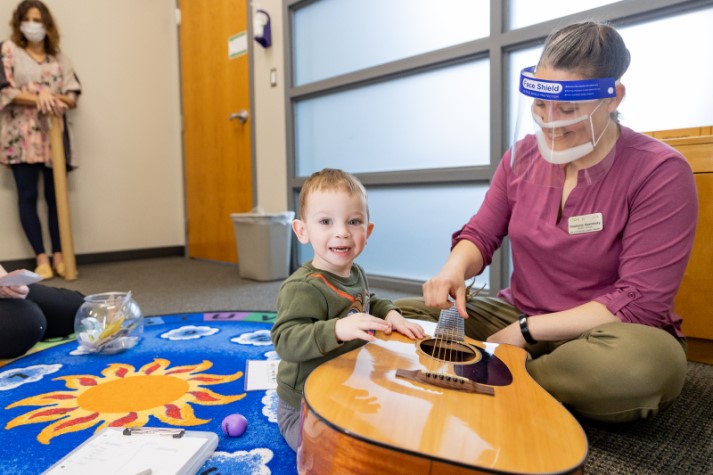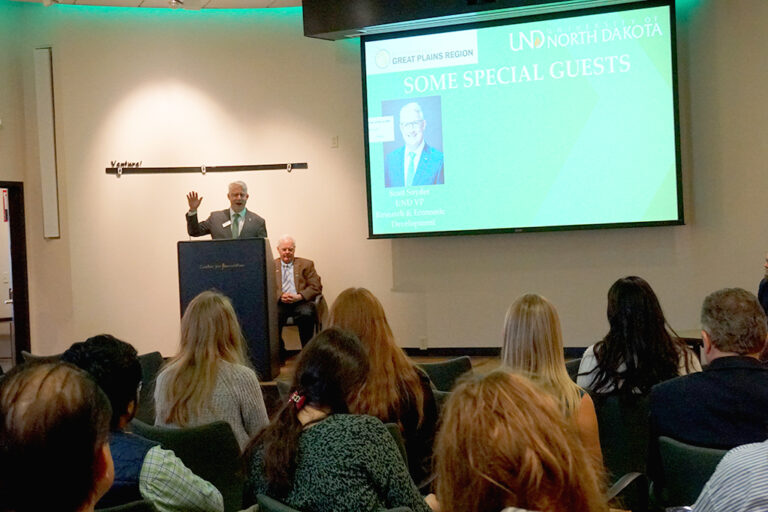Clear masks help clear way for serving patients in the pandemic
Speech-language pathology staff, student clinicians get creative in order to provide services during pandemic

When UND’s Northern Prairie Community Clinic temporarily ceased in-person services last spring due to the pandemic, Maggie Eyre was determined to find a way for her four-year-old daughter to receive the services she needed.
Eyre’s child first started attending the Clinic when she was only 2, when she would swap around different sounds, making it hard for others to understand her.
With the guidance of the Clinic’s speech-language clinicians, her daughter has made great progress in two years, Eyre said. So, when the Clinic rolled out virtual sessions last spring and summer, it was an easy decision to attend them via Zoom, despite the added layer of technological coordination.
“They’d send me some of the materials beforehand so I could have some of the props that helped my child stay engaged and do the exercises,” Eyre said.
The Northern Prairie Community Clinic consists of three branches that provide services for mental health, substance use disorders and speech-language pathology. While the mental health program has offered telehealth options for several years now, the speech-language pathology consultants began virtual sessions as a result of the pandemic.
After all, it is hard to work on proper enunciation with patients remotely because they need to not only hear the right sounds, they have to see how they are made. On camera, things can get lost, especially when a clinician is leading a group appointment, not a one-on-one session.
The speech-language pathology staff, however, quickly put together virtual programs with professional sound and video equipment that the College of Arts & Sciences helped purchase.

The pivot to remote services last spring and summer semester not only allowed patients like Eyre’s daughter to maintain their progress, but also exposed student clinicians to a growing segment of healthcare: tele-therapy.
“Tele-therapy really does open a new window and is a new skill for us to learn,” said Taryn Moe, a graduate student clinician.
In the months when virus infections climbed in the state, patients appreciated the safety of online services, too. Some of them are now even preferring them.
“Just the other day, one of our patients told us that even though he can now come back in person, he likes Zoom,” said Jessica Foley, one of the Clinic’s three directors. “He said, ‘I think it’s cool, and I’m just going to stay on Zoom.’”
Clear masks help deliver in-person services
As virtual sessions were taking place in the spring and summer, Foley and other Clinic professors and staff were busy putting together a plan to reopen the facility in the fall semester in accordance with safety ordinances.
Early on, it became clear that cloth masks would obstruct efficient speech sessions by covering individuals’ faces. Even if faculty could elect to only wear face shields, student clinicians and patients needed a solution that could work for them as well.
“We knew how important it would be for our patients to still get all the visual cues and all the information from our clinicians, when they’re working on their speech goals and their language goals,” said Carla Steen, Communication Sciences & Disorders program supervisor. “We know that for our older clients, it’s so important to be able to see our faces because they might have hearing deficits. It’s important that they’re watching for our visual cues.”
Enter the clear masks. Steen researched companies that produce transparent facial masks that reveal their wearer’s mouth, while blocking the spread of aerosols and fluids. The College of A&S helped the Clinic foot the bill for the masks, which are more expensive than regular face coverings. The Clinic was able to provide clear masks to patients as well.

Boasting an anti-fog plastic barrier, each clear mask comes with special foam strips that help it rest on the chin and nose, while an adjustable strap goes over the head.
At first, they feel different, said Moe, but they don’t take long to get accustomed to. Obviously, the clear masks also look different, often eliciting “oohs” and “aahs” from patients, Steen said. Children are usually most impressed, if not sometimes perplexed by the need to wear a mask in the first place.
For Eyre’s household, adjusting to mask wearing was a rather easy process, she said, initiated through a conversation with her three children why it is important to do so. This allowed her to bring her daughter to the Clinic when in-person services resumed.
“She makes great progress there,” Eyre said. “I’m very happy with the enthusiasm. We’ve had a lot of great student clinicians over the last two years. I love to see the different ideas that each student brings in, their creativity and their passion and how that then excites my child and motivates her. So we will continue doing it as long as she needs it.”
Despite the adjustments and challenges of the last academic year, the fact that the Clinic remained open – virtually and physically – not only benefited patients, it ensured that students did not lose any clinical hours, which are critical for on-time graduation.
“We’re very fortunate at UND that we didn’t lose out on any clinic hours,” said Moe. “Because I know, during the pandemic, people were struggling at some other institutions to get all of their hours for graduation.”


